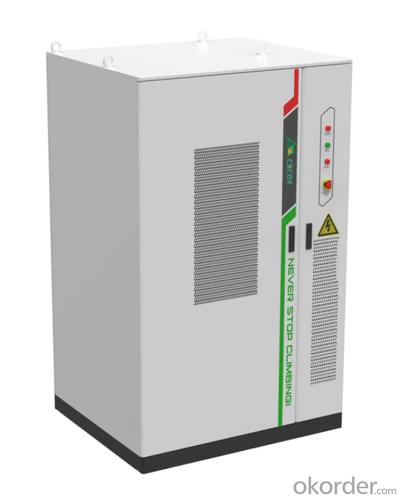See Through Solar Cells 100kw215kwh 672~876v 280ah Efficient and Smart Air-Cooling Cabinet Commercial/Industrial Storage
- Loading Port:
- SHANGHAI
- Payment Terms:
- TT OR LC
- Min Order Qty:
- 5 unit
- Supply Capability:
- 200 unit/month
OKorder Service Pledge
OKorder Financial Service
You Might Also Like
Specification
Product Features
Ultimate Safety
Partition security isolation design
Highly automated CCS integrated design
Electrical multidimensional fusion perception
Three-level relay protection design
Smart and Efficient
Panoramic online monitoring and scheduling
PACK level intelligent thermal management
Cold and hot cycle isolation design, up to 90% overall efficiency
BMS active balancing extends system life by 20%
Digital smart EMS system
Flexible and Convenient
Modular design, standardized interface
Multi-sensor and intelligent control system
Flexible expansion, multiple machines in parallel, 1.7m² single cabinet footprint
Triple level modular PCS, up to 99% maximum efficiency
Embedded air conditioning design
Quick Response
Access to cloud platforms, supporting multi-device access and multi-user sharing
Millisecond response to power dispatch
100% pre-installed integration
Support direct photovoltaic access
Equipped with LVRT, HVRT functions, and various control modes such as PQ, VF, and networking
Commercial & Industrial Battery
Product Parameters
Battery Type :LFP-280Ah
System Configuration:15*1P16S
Rated Charge/Discharge Ratio:≤0.5P
Rated Capacity:215Kwh
DC Rated Voltage:768V
DC Voltage Range:672 ~ 876V
AC Rated Power:100kW
AC Rated Voltage:400V±15%
Rated Grid Frequency:50Hz/60Hz
Cooling Mode:Efficient and Smart Air-Cooling
Size(W*D*H):1435*1215*2320mm&1700*1215*2320mm
Weight:2.5t/2.7t
Relative Humidity Range:5% ~ 95%(Non condensation)IP55
Operating Altitude:≤2000m(>2000m Reduction)
Fire Protection System:Aerosol/Perfluoro
Communication Interfaces:CAN/RS485/Ethernet
PV Direct Access,Seamless Switching of Parallel/Off-network
- Q: What is the maximum efficiency achievable by a solar cell?
- The maximum efficiency achievable by a solar cell is determined by the Shockley-Queisser limit, which states that the theoretical maximum efficiency is around 33.7%. However, in practice, most commercially available solar cells have efficiencies ranging between 15% to 22%.
- Q: Can solar cells be used on curved surfaces?
- Yes, solar cells can be used on curved surfaces. In fact, advancements in technology have made it possible to design flexible solar cells that can be curved to fit various shapes and structures, allowing for more versatile and efficient use of solar energy.
- Q: Can solar cells be used in theme parks or amusement parks?
- Yes, solar cells can definitely be used in theme parks or amusement parks. Solar cells can be installed on rooftops, parking lots, and other open spaces within these parks to generate clean and renewable energy. This energy can be utilized to power rides, lighting systems, water features, and other facilities within the park, reducing reliance on traditional power sources and lowering carbon emissions. Moreover, solar panels can also serve as educational tools, allowing park visitors to learn about renewable energy and sustainability.
- Q: What is the impact of pollution or smog on solar cell performance?
- The impact of pollution or smog on solar cell performance is significant. Pollutants in the air, such as particulate matter and chemicals, can accumulate on the surface of solar panels, reducing their efficiency by blocking or scattering sunlight. This leads to a decrease in the amount of electricity generated by the solar cells. Smog, which is a combination of smoke and fog, can further exacerbate the problem by reducing the amount of sunlight reaching the solar panels. Overall, pollution and smog can significantly hamper the performance of solar cells, resulting in lower energy production.
- Q: What can be used as the materials for solar cells?
- As far as I know, silicon is used as the material for solar cells.
- Q: How do solar cells handle snow or ice buildup?
- Solar cells are designed to handle snow or ice buildup by being installed at an angle, which allows for the snow or ice to slide off. Additionally, the dark surface of solar cells tends to absorb sunlight and heat, which can help melt any accumulated snow or ice.
- Q: Can solar cells be used in residential communities?
- Yes, solar cells can be used in residential communities. In fact, they are increasingly being adopted by homeowners as a sustainable and cost-effective alternative to traditional energy sources. Solar panels can be installed on rooftops or in open spaces within residential areas, harnessing sunlight to generate electricity for individual households or even for the entire community. This not only helps reduce reliance on fossil fuels but also enables homeowners to save on energy costs in the long run.
- Q: Where can I find more information about the work process of solar cells
- From wikipedia, where you can find almost everything you need.
- Q: Is that true that the price of solar cells will be reduced in the coming year?
- There are some policy change from the central government that financial subsidies of purchasing solar cells from the government will be lowered compared to last year. This could be a big reason for the price going down.
- Q: Can solar panels be charged with light?
- Since the output power of solar modules depends on factors such as solar irradiance and solar cell temperature, it is not recommended to use light charging, efficiency is not only very low, and also meaningless.
Send your message to us
See Through Solar Cells 100kw215kwh 672~876v 280ah Efficient and Smart Air-Cooling Cabinet Commercial/Industrial Storage
- Loading Port:
- SHANGHAI
- Payment Terms:
- TT OR LC
- Min Order Qty:
- 5 unit
- Supply Capability:
- 200 unit/month
OKorder Service Pledge
OKorder Financial Service
Similar products
Hot products
Hot Searches
Related keywords






















